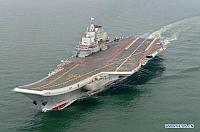
Now that China has finally commissioned Liaoning, its first aircraft carrier, the discussion has focused on whether the ship is a meaningful addition to the Chinese Navy or merely a symbol of status and prestige. Some have pointed out that the Chinese are not believed to currently have enough carrier-capable fighter aircraft to make the ship operational. On the other hand, China does have a carrier based plane under development, so the question may be simply be how long it will take to produce the planes. Regardless, it may be that simply having an aircraft carrier provides sufficient prestige at a time when Western powers are cutting back their aircraft carrier fleets.
The New York Times reports that military experts say that “China does not have planes capable of landing on the carrier and so far training for such landings has been carried out on land.”
The Chinese have however been developing a carrier based fighter plane, the Shenyang J-15, based on the Russian naval fighter, the Sukhoi Su-33. Videos of test flights of the J-15 appeared on Youtube over two years ago. We posted in May of last year about the training taking place on the mocked-up deck of an aircraft carrier installed on the roof of a Chinese government building near the city of Wuhan. (See China takes a Great Leap Forward in the Concrete Carrier Arms Race) Reports were that the Chinese were training with Russian SU-33 aircraft and naval helicopters from the concrete flight deck. So, while it may be accurate to say that “China does not have planes capable of landing on the carrier” it might be appropriate to add the modifier “yet” to the end of the statement. How soon the Chinese will have carrier-capable aircraft is unclear, but they working toward that end.
Duncan Hewitt in the Daily Beast comments on the larger issue of strategy versus status.
“Some analysts have suggested owning an aircraft carrier is like the military equivalent of middle-aged men wanting to drive expensive sports cars—it’s all about status and symbolism. For China, being able to project its military power further into the seas off its eastern and southern coasts, where it has various disputes with its neighbors over offshore islands, is clearly important; but having East Asia’s first aircraft carrier (like having a space program) is also simply seen as a way of showing that the country has arrived on the global stage.”
The problem with a high status ship like the Liaoning is that it may be too valuable to use. From the New York Times:
You Ji, a visiting senior research fellow at the National University of Singapore, said in an interview. “If it is used against America, it has no survivability. If it is used against China’s neighbors, it’s a sign of bullying.”
Vietnam, a neighbor with whom China has fought wars, operates land-based Russian Su-30 aircraft that could pose a threat to the aircraft carrier, Mr. You said. “In the South China Sea, if the carrier is damaged by the Vietnamese, it’s a huge loss of face,” he said. “It’s not worth it.”
Thanks to Phil Leon for contributing to this post.
